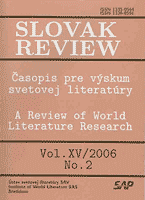Ďurišin: smerovanie k medziliterárnosti a k procesovosti v očiach sveta
Ďurišin: The Drift towards Interliterariness and Processuality from the Point of View of the World
Author(s): Pavol KoprdaSubject(s): Literary Texts
Published by: Ústav svetovej literatúry, Slovenská akadémia vied
Keywords: Formalism; Structuralism; Interliterariness; Dionýz Ďurišin - Continuity of his Theory with Recent Tendencies
Summary/Abstract: The objective of the paper is to point at the superficial character of contemporary sociology and culture oriented trends in the research of interliterariness. It has been very often neglected that the object of literature research is the beauty of literature, as that which causes changes in the development. There was a Russian-Slovak (and structuralist) chapter in the history of interliterariness. At present it lives as a whole in the world but its findings have been utilized differently. Unfortunately, it appears that the theses of the Russian-Slovak school have been exploited for utilitarian goals. Instead of the aesthetic essence of a phenomenon in its historical form, which was Ďurišin´s intention, models of literature subjugated to a cultural interest has become an objective of the research of interliterariness. These models are sometimes very aggressive: the study of an alien culture by the stronger in order to control the weaker, etc. The paper introduces the key concepts of Russian formalism of Veselovsky´s historical poetics and Mukařovsky´s structuralism as they were elaborated by Dionýz Ďurišin and those who understand him in a most consequent way, i. e. mainly J. M. Lotman and Z. Konstantinovic. The paper is also devoted to the various forms in which Ďurišin is present in the contemporary theory of interliterariness. Miner maintains that “comparisons are more stimulating if they place real differences into mutual relationships”. Lotman proves that Ďurišin found out that a difference in the sign (of a structure) is equally relevant as the difference between the literature of Western Europe and that of Japan Otherwis “there would be no aesthetic reading of literary texts. Nowadays, even the thematic criticism (Harry Perkins) holds that literature is based on a difference (distance) of what is actually close. In spite of this, Ďurišin is conceived of as a founder of the transition of literary research from intraculturality to interculturality (he is assessed by Cesar Dominguez in this way, for instance), i. e. as a theoretician of “big differences”. This misunderstanding was also caused by the one-sided interpretation of Žirmunskij/Ďurišin concept of typological connections Claudio Guillen, for example, introduced it in such a way that he was able to construct the history of world literature as a history of analogyness of geographically very distant phenomena. Unfortunately, the idea that only a big difference is a difference, and that only a big difference is worth of examination, and that all minute differences are forms of identity is so wide-spread that it creates a new situation in the theory of interliterariness in the form of a return to big literatures, to big literary phenomena. This idea is dangerous to the Slovak literature, to the Slavonic interliterary community, to the Czecho-Slovak interliterary community, and, generally, to interliterary communities which are a form of existence of world literature.
Journal: Slovak Review of World Literature Research
- Issue Year: 2006
- Issue No: 02
- Page Range: 122-146
- Page Count: 24
- Language: Slovak

